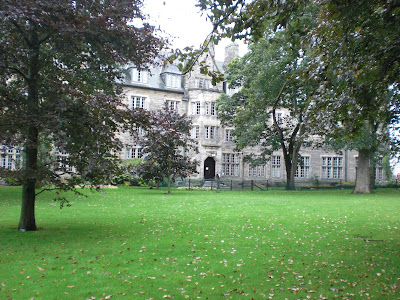I've posted them in the order you would encounter them if you were walking from Edgecliffe to Anstruther (south).
First, Edgcliffe Hall. If you maximize the picture, you can see two doors, one marked 'Moral Philosphy' and the other marked 'Logic and Metaphysics.' These both lead to the same antechamber, but which door you walk into in a minor proclamation of your philosophical intentions. Since I think that interest in one entails interest in the other, I walk in and out of either with 'reckless abandon.'
St. Andrews is very well maintained for a medieval city. But occasionally you can spot the classic British punk shibboleth:
But this is not Italy. In fact, I think this is the only urban scrawl I've spotted in the neighborhood. At any rate, just across the street from Edgecliffe is the central campus, host to most of the undergraduate buildings:
These are collectively referred to as St. Salvatore's College. This college, the first of what became the University of St. Andrews, was founded in 1413. As such, it is the third oldest in the English speaking world. These buildings are certainly larger than the original campus.
The castle of St. Andrews was built by the bishops in residence at St. Andrews. I'm not sure why they built the castle in the first place, but it saw extensive military action during the Wars of Scottish Independence. The castle has a fascinating history, of which I know very little. The Wikipedia entry is a good sampler: Castle of St. Andrews.
Further south is St. Andrew's cathedral. It fell into ruin after the Scottish Reformation. At one time is was, if my friend is to be trusted, the largest cathedral in the world. You can see that it was once very large. Though the chuch is mostly ruined, the grounds are very well kept. Walking around the remnants is very peaceful.
Moving further south:
U. of St. Andrews has a lot of strange traditions. Like in Harry Potter, long, flowing gowns are popular. Professors wear them to class, students wear them to public debates at Lower Parliament Hall, and after church every Sunday, everyone walks in their brilliant red robes down this pier:
There are more pictures here: Picasa Album.
Pictures never do it justice.
For those of you concerned about my cooking abilities, the following is evidence of my progress. Thank you Shirle and Lisa for the help.
Despite these improvements, however, I am still very much a classless bachelor.





















Please take a picture of the long red robes walking down the pier on Sunday. I simply must see that. I like the salad and tomatoes. That is progress! Thank you for pictures.
ReplyDeleteAnd don't tread across those stones, son..... your exams will be cursed! LOL Maybe you got too close taking the picture even. Better jump in the water just in case. Don't forget about the allrecipes.com site. Good cooking!
ReplyDeleteDUDE scotland looks awesome. SO PRETTY!!!!!!!!!!!!!!!!!!!! jk rowlings home! ;)
ReplyDelete